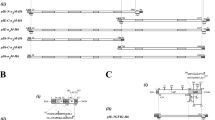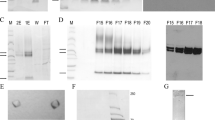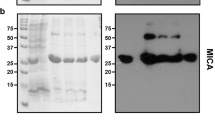Abstract
Human interferon–α2 (IFN–α2), an 18 kD, acidic protein, human interferon–γ (IFN–γ), a 17 kD, basic protein, and the interferon–induced murine protein Mx (72 kD) were all found in aggregates when produced in genetically engineered strains of E. coli grown at 37°C. However, at a growth temperature of 23–30°C, 30–90% of the recombinant protein was soluble. The temperature effect was not directly dependent on the concentration of the protein and was observed for several E. coli strains and for different plasmid constructions. Lysates of non–transformed E. coli grown at either temperature rendered initially soluble human recombinant IFN–α2 insoluble at 37° but not at 0° or 30°C. Insolubilization was not abolished by nuclease treatment, and may involve sulfhydryl group shuffling, as sulfhydryl reducing agents added to a mock lysate gave a similar temperature dependent precipitation.
This is a preview of subscription content, access via your institution
Access options
Subscribe to this journal
Receive 12 print issues and online access
$209.00 per year
only $17.42 per issue
Buy this article
- Purchase on Springer Link
- Instant access to full article PDF
Prices may be subject to local taxes which are calculated during checkout
Similar content being viewed by others
References
Williams, D.C., Van Frank, R.M., Muth, W.L., and Burnett, J.P. 1982. Cytoplasmic inclusion bodies in Escherichia coli producing bio-synthetic human insulin proteins. Science 215:687–689.
Schoner, R.G., Ellis, L.F., and Schoner, B.E. 1985. Isolation and purification of protein granules from Escherichia coli cells overproducing bovine growth hormone. Bio/Technology 3:151–154.
Schoemaker, J.M., Brasnett, A.H., and Marston, F.A.O. 1985. Examination of calf prochymosin accumulation in Escherichia coli disulphide linkages are a structural component of prochymosin-containing inclusion bodies. EMBO J. 4:775–780.
Mark, D.F., Lu, S.D., Creasey, A.A., Yamamoto, R., and Lin, L.S. 1984. Site-specific mutagenesis of the human fibroblast interferon gene. Proc. Natl. Acad. Sci. USA 81:5662–5666.
Gray, P.W., Leung, D.W., Pennica, D., Yelverton, E., Najarian, R., Simonsen, C.C., Derynck, R., Sherwood, P.J., Wallace, D.M., Berger, S.L., Levinson, A.D., and Goeddel, D.V. 1982. Expression of human immune interferon cDNA in E. coli, and monkey cells. Nature 295:503–508.
Staeheli, P., Haller, O., Boll, W., Lindenmann, J., and Weissmann, C. 1986. Mx protein: constitutive expression in 3T3 cells transformed with cloned Mx cDNA confers selective resistance to influenza virus. Cell 44:147–158.
Morehead, H., Johnston, P.D., and Wetzel, R. 1984. Roles of the 29–138 disulfide bond of subtype A of human α interferon in its antiviral activity and conformational stability. Biochemistry 23:2500–2507.
Prouty, W.F., Karnovsky, M.J., and Goldberg, A.L. 1975. Degradation of abnormal proteins in Escherichia coli. Formation of protein inclusions in cells exposed to amino acid analogs. J. Biol. Chem. 250:1112–1122.
Traub, P. and Nomura, M. 1969. Structure and function of Escherichia coli ribosomes. VI. Mechanism of assembly of 30S ribosomes studied in vitro. J. Mol. Biol. 40:391–413.
Kato, T. and Anfinsen, C.B. 1969. On the stabilization of ribonuclease S-protein by ribonuclease S-peptide. J. Biol. Chem. 244:1004–1007.
Sogami, M., Petersen, H.A., and Foster, J.F. 1969. The microheterogeneity of plasma albumins. V. Permutations in disulfide pairings as a probable source of microheterogeneity in bovine albumin. Biochemistry 8:49–58.
Hillson, D.A., Lambert, N., and Freedman, R.B. 1984. Formation and isomerization of disulfide bonds in proteins: protein disulfide-isomerase. Methods in Enzymology 107:281–294.
Remaut, E., Tsao, H., and Fiers, W. 1983. Improved plasmid vectors with a thermoinducible expression and temperature-regulated runaway replication. Gene 22:103–113.
Panayotatos, N., Fontaine, A., and Truong, K. 1983. A cop− mutation causes a specific 200 fold increase in interferon levels expressed from the colE1 replication promoters. J. Cellular Biochem. Suppl. 7:109.
Valenzuela, D., Weber, H., and Weissmann, C. 1985. Is sequence conservation in interferons due to selection for functional proteins? Nature 313:698–700.
Thatcher, D.R. and Panayotatos, N. 1986. Purification of recombinant human IFN-α2. Methods in Enzymology 119:166–177.
Laemmli, U.K. 1970. Cleavage of structural proteins during the assembly of the head of bacteriophage T4. Nature 227:680–685.
Messing, J. 1983. New M13 vectors for cloning. Methods in Enzymology 101:20–78.
Aebi, M., Hornig, H., Padgett, R.A., Reiser, J., and Weissmann, C. 1986. Sequence requirements for splicing of higher eukaryotic nuclear pre-mRNA. Cell 47:555–565.
Edman, J.C., Hallewell, R.A., Valenzuela, P., Goodmann, H.M., and Rutter, W.J. 1981. Synthesis of hepatitis B surface and core antigens in E. coli. Nature 291:503–506.
Rink, H., Liersch, M., Sieber, P., and Meyer, F. 1984. A large fragment approach to DNA synthesis: Total synthesis of a gene for the protease inhibitor eglin c from the leech Hirudo medicinalis, and its expression in E. coli. Nucleic Acids Res. 12:6369–6387.
Nagata, S., Taira, H., Hall, A., Johnsrud, L., Streuli, M., Ecsödi, J., Boll, W., Cantell, K., and Weissmann, C. 1980. Synthesis in E. coli of a polypeptide with human leukocyte interferon activity. Nature 284:316–320.
Author information
Authors and Affiliations
Rights and permissions
About this article
Cite this article
Schein, C., Noteborn, M. Formation of Soluble Recombinant Proteins in Escherichia Coli is Favored by Lower Growth Temperature. Nat Biotechnol 6, 291–294 (1988). https://doi.org/10.1038/nbt0388-291
Received:
Accepted:
Issue Date:
DOI: https://doi.org/10.1038/nbt0388-291
This article is cited by
-
Expression and characterization of rainbow trout Oncorhynchus mykiss recombinant myoglobin
Fish Physiology and Biochemistry (2021)
-
Predictive approaches to guide the expression of recombinant vaccine targets in Escherichia coli: a case study presentation utilising Absynth Biologics Ltd. proprietary Clostridium difficile vaccine antigens
Applied Microbiology and Biotechnology (2021)
-
Optimization and scale-up production of Zika virus ΔNS1 in Escherichia coli: application of Response Surface Methodology
AMB Express (2020)
-
Effect of gene dosage and incubation temperature on production of β-mannanase by recombinant Pichia pastoris
Journal of Central South University (2019)
-
Translation enhancement by a Dictyostelium gene sequence in Escherichia coli
Applied Microbiology and Biotechnology (2019)



